Price: from $46,990 plus options and on-road costs
Engine/Trans: 200kW/380Nm 4.0-litre V6 / 5-speed automatic
Fuel Economy claimed: 11.4 l/100km combined
Construction: Ladder-frame
Suspension: double-wishbone front and multi-link rear
Towing: 2250kg braked / 750kg unbraked
Vehicle class: off-road passenger vehicle (MC)
Part homage to the legendary FJ40, with more than a little bit of Tonka Truck thrown in, the FJ Cruiser was never really meant for the Australian market.
It started life as a concept car in 2003 and went into production two years later in lefthand drive, but it took another five years before the steering wheel made it to the right side of the car.
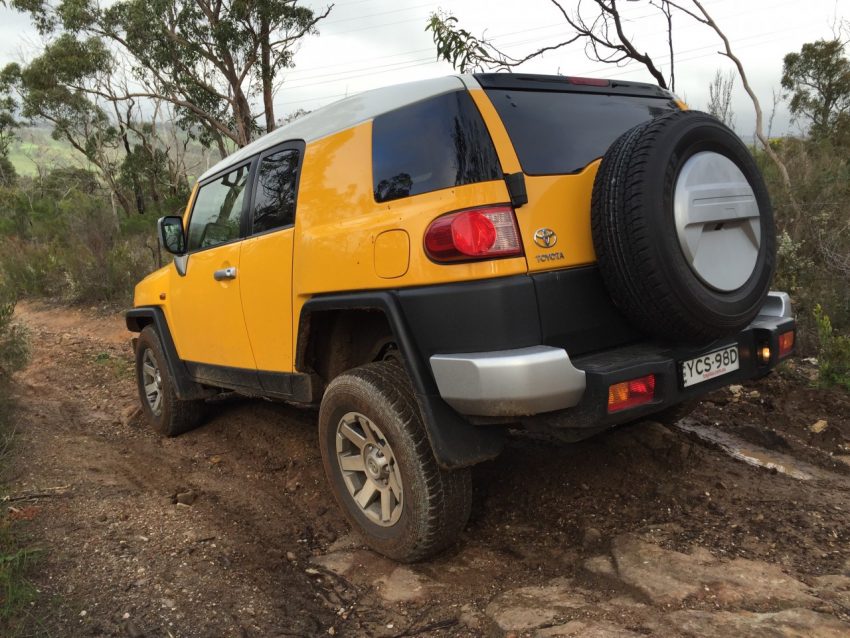 The fan base has quietly expanded since its arrival in 2011 – they’ve sent over 11,000 to good homes in Australia despite the absence of a diesel and a paltry petrol tank in the earlier incarnations.
The fan base has quietly expanded since its arrival in 2011 – they’ve sent over 11,000 to good homes in Australia despite the absence of a diesel and a paltry petrol tank in the earlier incarnations.
Almost a short wheelbase petrol V6 Prado in funkier fettle, the $46,990 FJ Cruiser (not far off the entry-level Fortuner GX) is cartoon-like in its take on the legendary FJ40 that’s still a regular sight on some country roads.
The grille and headlights are reminiscent of the old FJ soldier, but rear-hinged 90-degree half doors for the back seat access (which requires side steps from the accessories catalogue for ‘easy’ access) weren’t part of the original recipe.
Once inside there’s a decent amount of space in the rear seat, although the fixed rear glass won’t please some occupants of the rear bench.
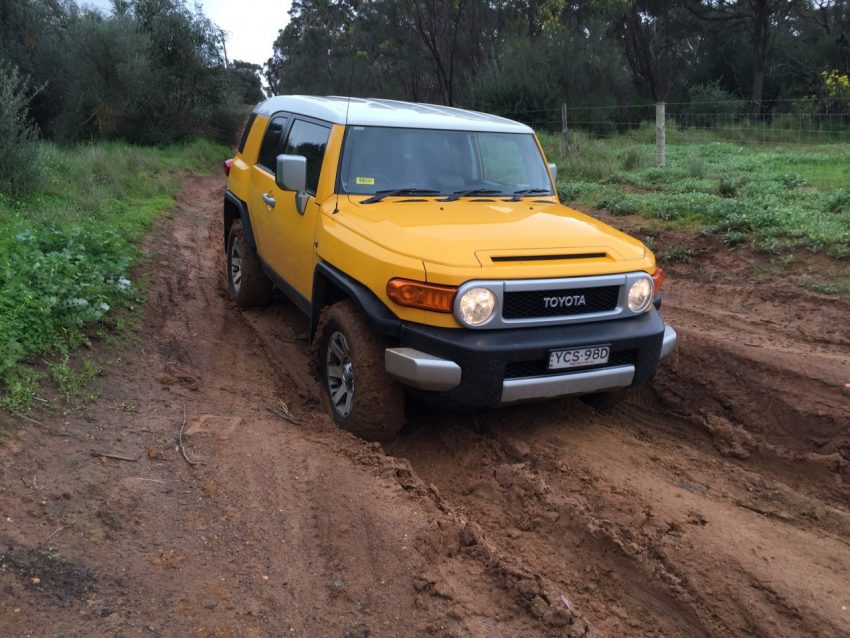 Beneath the homage styling, the features list includes touchscreen-controlled satnav, Bluetooth and USB connections, rear fog lights, tinted ‘privacy’ glass, cruise control, manual air-conditioning, a leather-wrapped steering wheel with audio controls, cloth trim, manual seat adjustment for the comfortable seating, cupholders front and rear, height adjustable seating for the driver, a dash-top multi-information display with temperature, compass and inclinometer, an eight-speaker sound system, halogen headlights and central locking.
Beneath the homage styling, the features list includes touchscreen-controlled satnav, Bluetooth and USB connections, rear fog lights, tinted ‘privacy’ glass, cruise control, manual air-conditioning, a leather-wrapped steering wheel with audio controls, cloth trim, manual seat adjustment for the comfortable seating, cupholders front and rear, height adjustable seating for the driver, a dash-top multi-information display with temperature, compass and inclinometer, an eight-speaker sound system, halogen headlights and central locking.
The driver has a nice leather-wrapped steering wheel (but sadly tilt-only adjustment), clear instruments (but no trip computer) and restricted three-quarter and direct rear vision, hampered by the spare mounted on the tailgate (itself an awkward thing to operate) and the absence of illumination for some of the switchgear.
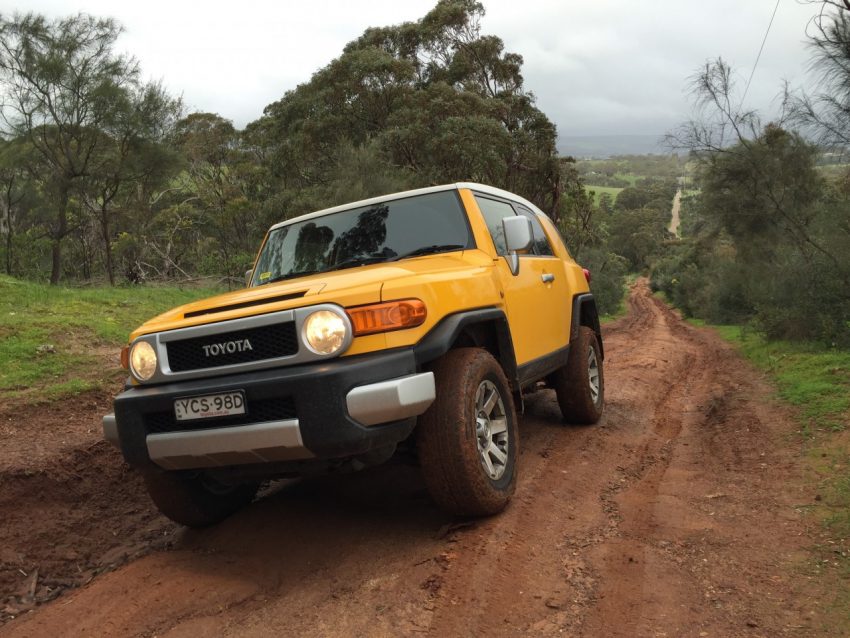 The distance from occupant to windscreen gave rise to a useful second sun visor to the side, which flips down from the grab handle, rather than a second blade ahead of the driver.
The distance from occupant to windscreen gave rise to a useful second sun visor to the side, which flips down from the grab handle, rather than a second blade ahead of the driver.
The FJ is not retro when it comes to safety features either, with six airbags, stability control, anti-lock brakes with brake assist and electronic brake-force distribution, active front head restraints, rear parking sensors and a reversing camera displaying on the auto-dimming centre rear-view mirror, which is not ideal but better than nothing.
The drivetrain is the 4.0-litre V6 petrol engine with five-speed automatic transmission straight from the Prado parts bin, so it’s not going to be described by anyone as cutting edge.
The alloy V6 has 24 valves, variable valve timing and double overhead cams to produce 200kW at 5600rpm and 380Nm at 4400rpm.
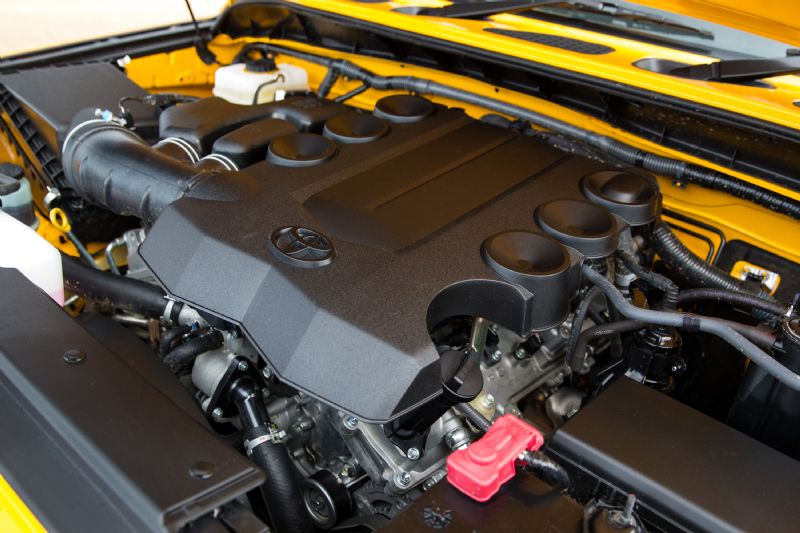
It’s punchy enough in the top end to get the FJ rolling smartly to 100km/h in around 8 seconds, whereafter it cruises at around 2000rpm, but you’ll pay for it at the pump if rapid departures are part of the driver’s daily routine or there’s a lot of off-road work in the schedule.
The ADR fuel economy claim on the combined cycle is 11.4 litres per 100km, rising to 15 on the city cycle and 9.3 on the highway, but it prefers 95RON PULP.
The FJ drank it at a rate of 14.7 litres per 100km during our time with the vehicle, but the fuel capacity expansion from 72 to 159 litres takes the range anxiety down a little to suggest 1000km on the fuel carried.
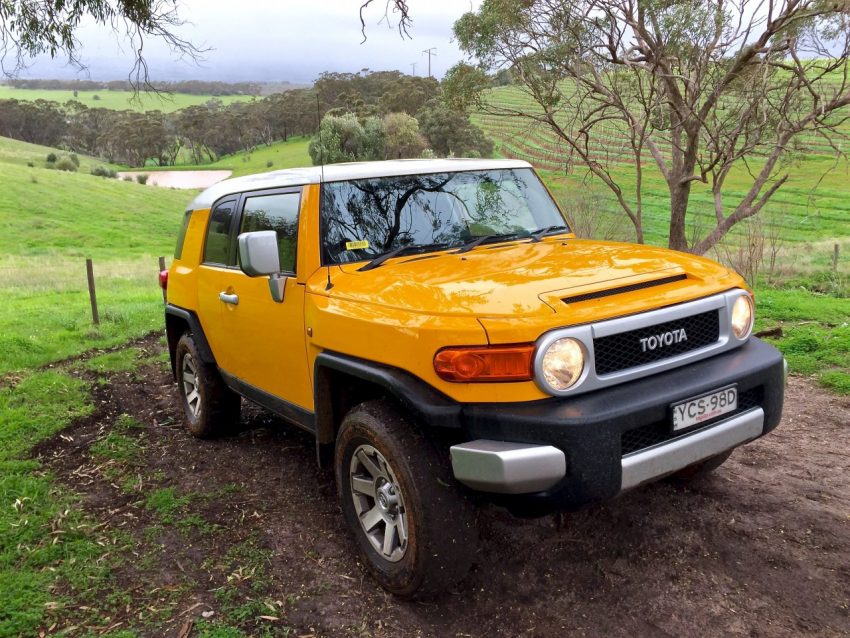
The 17-inch alloy wheels are controlled by an independent double wishbone front and multi-link rear suspension systems have large diameter dampers, coil springs and anti roll bars and runs a locally-developed calibration (including a power steering tweak) that delivers a good ride quality without quite turning it into an aquatic conveyance in the corners.
It runs a part-time 4WD system – meaning rear wheel drive until you’re off the beaten track as there’s no on-road AWD option, something Mitsubishi is more astute in offering in the Pajero and Triton.
Fast dirt is dealt with best in 4WD if the driver has no interest in amusement; leaving it in RWD and turning off the electronics is a more amusing and attention-grabbing, if less sociable, way from A to B on an unsealed road.
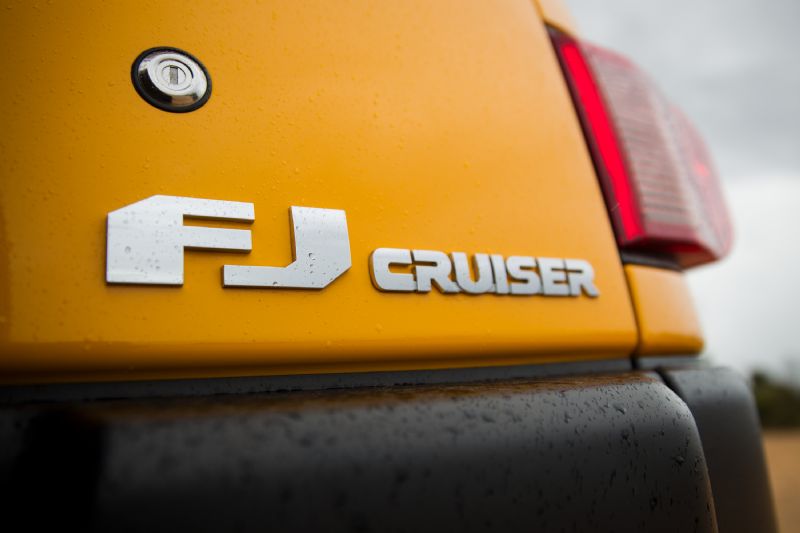
Once headed properly off road, the drivetrain has a rear differential lock and the brand’s Active Traction Control, which uses the four-wheel ventilated disc brakes to control wheel spin in low range 4WD and Toyota’s CRAWL off-road cruise-control system that Toyota claims controls engine and brakes to maintain low speeds over severe or slippery terrain.
The system works below 25km/h in low range – or 10km/h when the rear differential is locked – with the pace dictated by the five-step speed dial on the overhead console; it makes a reasonable fist of that task but it is abrupt in its application and can get lurchy.
Off-road work showed the 224mm of clearance is enough, without being substantial, but the underbody protection feels useful and robust; the electronics aren’t unobtrusive and do a pretty good job at maintaining traction to the limits of the standard tyres.
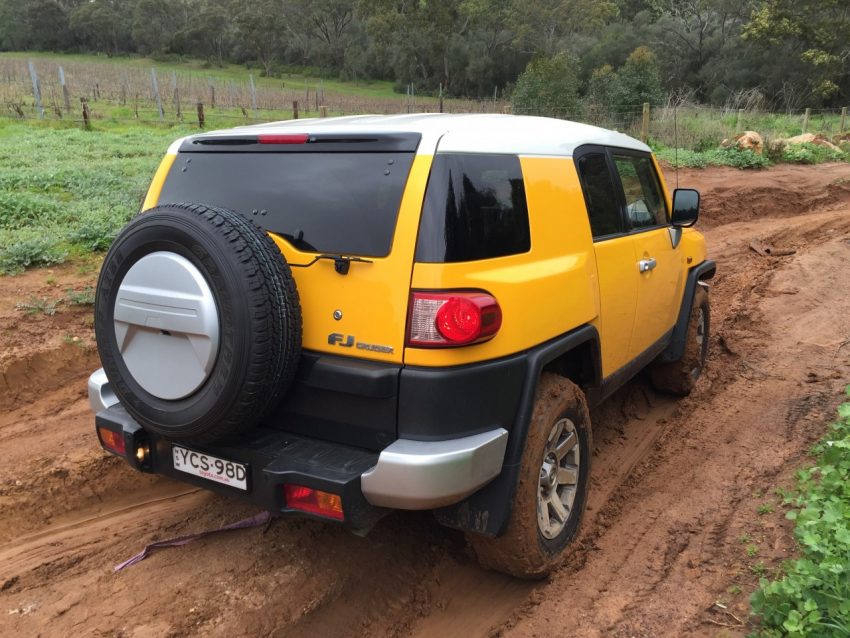 The Dunlop Grandtrek rubber was beaten by a steep, rutted incline and dark greasy mud, but it clambered over plenty of obstacles prior to the mud run.
The Dunlop Grandtrek rubber was beaten by a steep, rutted incline and dark greasy mud, but it clambered over plenty of obstacles prior to the mud run.
The stumpy dimensions of the FJ Cruiser give it the best approach and departure angles of the breed – 36 degrees at the front and 31 degrees at the rear, with a 29-degree rampover angle – as well as a 700mm wading depth.
It measures 4670mm long, 1905mm wide, 1830mm tall with a 2690mm wheelbase, with a kerb weight bang on two tonnes; braked towing capacity of 2250kg isn’t class-leading but the Prado hasn’t improved recently either.
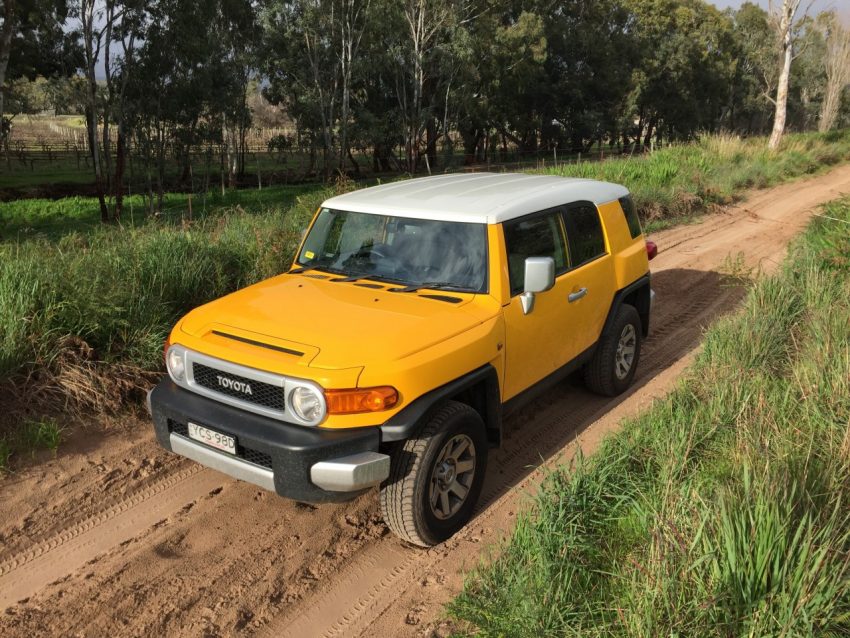 Local testing resulted in unique calibration of the heavy-duty all-coil suspension and power steering to suit Australian conditions and local coarse-chip road surfaces also brought about changes to the FJ Cruiser’s NVH insulation – adopted globally – and the cruising speed refinement and well-quelled wind and engine noise demonstrate the effort.
Local testing resulted in unique calibration of the heavy-duty all-coil suspension and power steering to suit Australian conditions and local coarse-chip road surfaces also brought about changes to the FJ Cruiser’s NVH insulation – adopted globally – and the cruising speed refinement and well-quelled wind and engine noise demonstrate the effort.
It is sad to see the FJ experiment end – it demonstrated sentimentality and showed a few enthusiasts who wistfully recalled the original FJ still haunted the halls of power at Toyota.
But without a diesel it was never going to make a series impact on the Australian 4WD market, now if I could just figure out a way to shove the new Prado’s engine into it…
[envira-gallery id=”7998″]





GIPHY App Key not set. Please check settings